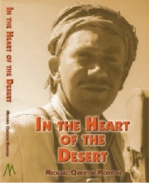In the Heart of the Desert

Michael Quentin Morton
Published by: Green Mountain Press
Publication date: 2007
ISBN: 978-0-9552212-0-0
List price: £20.00
266 pp
www.greenmountainpress.co.uk
This book is about the life of Mike Morton, a geologist with the Iraq Petroleum Company. Written by his younger son, it is mainly about Mike’s travels around the Middle East in the search for oil during the period 1945 to 1972.
Mike senior’s career started in Palestine in November 1945, carrying out regional mapping in the Dead Sea region and in Trans-Jordan. He had an early baptism of fire in the political upheavals of the Middle East, as he was in Jerusalem when "Jewish extremists" blew up the King David Hotel in July 1946.
After two years, Mike moved on to map in what is now the Yemen and Oman, where he experienced (enjoyed is probably stretching it) his first camel safari, endured with Yorkshire stoicism. Over the next 10 years, Mike went on to do fieldwork along much of the Hadhramaut Coast, and also in Jordan and Syria. In the latter, he and another geologist were arrested at gunpoint because they had strayed 10 yards inside the unmarked Turkish frontier. Other responsibilities were added at this time: Mike married Heather in 1949, and in 1950 she came out to join him at Tripoli in Lebanon, where she did battle with cockroaches, bedbugs and kleptomaniac servants. From then until 1957, the couple led the kind of life familiar to many in the oil industry at that time – husband out in the field, wife at base camp, bringing up their two young boys.
In 1957 Mike was promoted to Head of Department, and moved to Head Office, first in Qatar, then Bahrain and Abu Dhabi. In 1971 he resigned from the IPC, but in the same year was appointed deputy leader of a RGS expedition to the Mussandam Peninsula of Oman. The region had been forbidden to outsiders for many years, but a palace coup in 1970 changed all that, allowing Mike and his party of geographers, surveyors and zoologists to explore the stark, lunar mountains and deep, sheer-sided wadis.
Things have changed vastly in the Middle East that Mike Morton knew and loved. Mention Jordan or Oman to most people today, and it conjures up images of rather novel holidays - Petra, hiking in the Jebel Akhdar - but it was a different matter in the 1950s and 60s. Much of the region was politically unstable, with ill-defined boundaries. Inter-tribal enmity frequently expressed itself as armed raids, and the Political Officer was just as important a part of the field party as the geologists themselves. Days might pass before a local Sheikh would give permission for the field party to cross his lands. There were frustrations, but there was also a continual feeling of excitement, spiced with a hint of danger lurking over the next dune. Mike was one of that small band of men who thrived on all of that. This book does him justice.
Pete Webb, Petrus Consulting